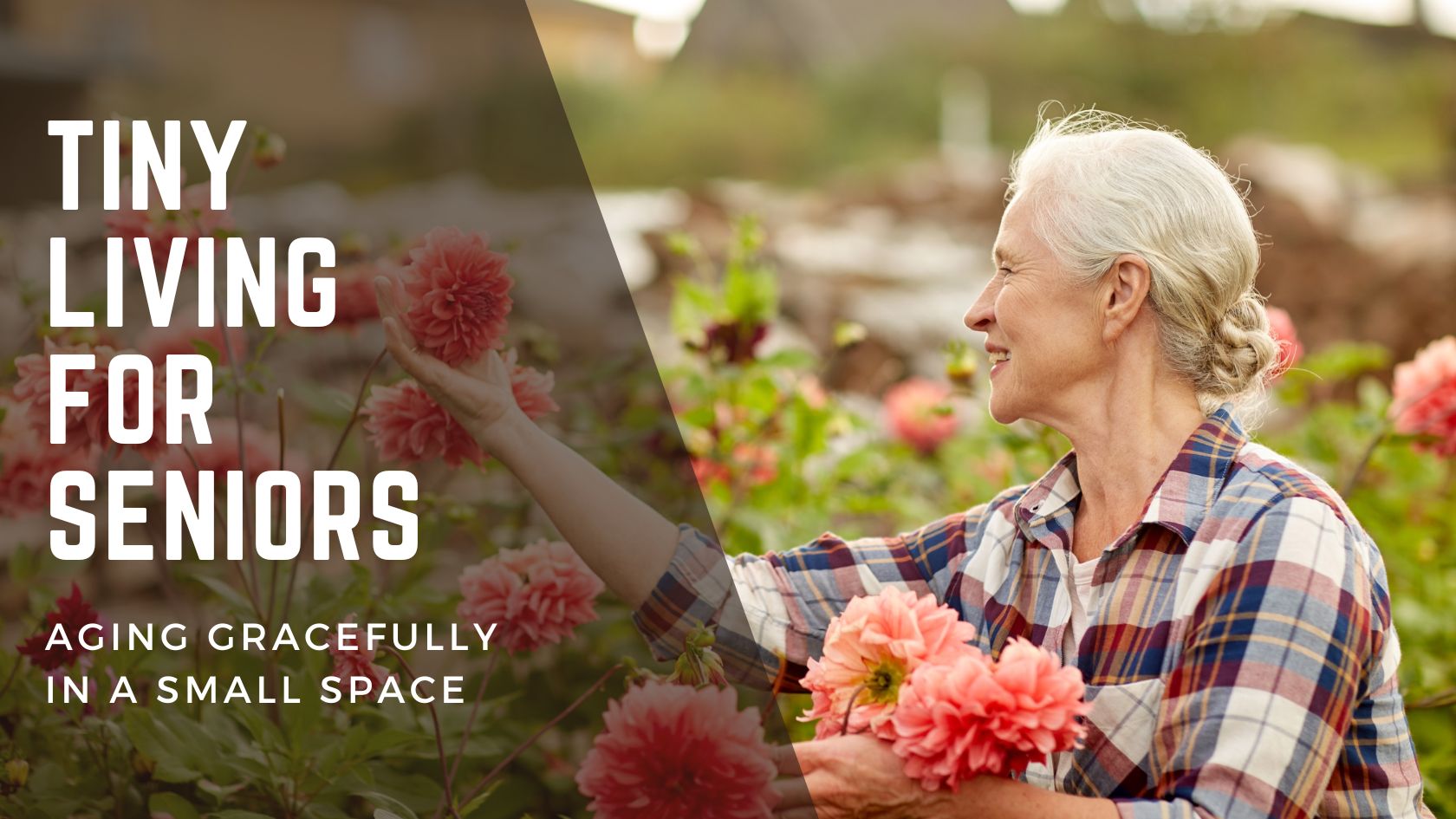
While tiny living is often associated with young couples or adventurous individuals, many seniors are finding that this lifestyle suits them perfectly. For seniors, tiny living offers a unique opportunity to simplify life, reduce costs, and focus on what truly matters in their golden years.
Why Consider Tiny Living as a Senior?
Tiny living is about adopting a lifestyle that focuses on enjoying experiences, keeping life simple, and choosing sustainability. For seniors, this approach can bring many benefits, including improved physical health, emotional well-being, and financial savings. Here are a few reasons why tiny living can be an appealing option for older adults:
Financial Freedom
Lower Cost of Living: Tiny homes are significantly less expensive to buy, maintain, heat, and cool than traditional homes. This reduced financial burden can be particularly beneficial for seniors living on a fixed income, allowing them to stretch their retirement savings further.
Minimal Upkeep: A smaller space naturally requires less time and money to maintain. This means fewer repairs, lower utility bills, and a reduced need for expensive cleaning services, allowing seniors to allocate their funds towards experiences rather than expenses.
Simplified Lifestyle
Less Clutter: Downsizing to a tiny home encourages seniors to declutter and keep only what’s truly necessary or brings joy. This can be a freeing experience, as a minimalist lifestyle often leads to less stress and more time to focus on meaningful activities.
Easy Navigation: Tiny homes are generally designed to maximize space efficiency and minimize physical barriers, making them easier to navigate for those with mobility issues. Features like single-story layouts, wide doorways, and open floor plans can be particularly advantageous.
Health and Well-Being
Promotes Physical Activity: Tiny homes often encourage more outdoor living, prompting seniors to engage in activities such as gardening, walking, or simply enjoying nature. This can improve physical health and reduce the risk of ailments associated with a sedentary lifestyle.
Mental Wellness: A clutter-free environment can significantly reduce stress and anxiety. Living in a small, manageable space can provide a sense of control and reduce the mental burden of maintaining a large home.
Closer Community Connections
Tiny Home Communities: Many tiny home dwellers choose to live in communities where they can share resources, activities, and social connections. These communities can provide a strong support network for seniors, fostering a sense of belonging and combating feelings of isolation.
Designing a Tiny Home for Aging in Place
When considering a tiny home, it’s important to consider how the design can accommodate the needs of aging. Here are some key features to consider when designing or choosing a tiny home for seniors:
Accessibility
Single-Level Living: To avoid the need for stairs, a single-level tiny home is ideal. This layout eliminates the risk of falls and ensures all areas of the home are easily accessible.
Wide Doorways and Hallways: Ensuring doorways and hallways are wide enough to accommodate mobility aids like walkers or wheelchairs is essential. The standard width should be at least 36 inches.
Non-Slip Flooring: Floors should be covered with non-slip materials to prevent falls. Consider options like cork, bamboo, or vinyl, which are safe and comfortable to walk on.
Safety Features
Grab Bars and Handrails: Installing grab bars in key areas, such as bathrooms and near entryways, can provide additional support and prevent falls. Handrails along corridors or steps are also beneficial.
Lever-Style Handles: Opt for lever-style handles instead of knobs for doors and faucets. They are easier to operate, especially for those with arthritis or limited hand strength.
Ample Lighting: Ensure there is sufficient lighting throughout the home, especially in hallways, stairs, and bathrooms. Motion-sensor lights can be a helpful addition for nighttime navigation.
Functional Kitchen Design
Lower Countertops and Cabinets: The kitchen should be designed with lower countertops and cabinets to ensure everything is within easy reach. Pull-out shelves and lazy Susans can also make accessing items easier.
Accessible Appliances: Consider appliances that are user-friendly and positioned at a comfortable height. A side-opening oven, a bottom-freezer refrigerator, and a front-loading washer and dryer are all excellent choices.
Comfortable Living Spaces
Multi-Functional Furniture: Furniture that serves multiple purposes can help maximize space without sacrificing comfort. Built-in storage solutions, such as under-bed drawers and wall-mounted shelves, can maximize space efficiency.
Comfortable Seating: Investing in ergonomically designed chairs and seating can make a significant difference in comfort, especially for seniors who may have back or joint issues.
The Emotional Benefits of Tiny Living for Seniors
Beyond the practical advantages, tiny living offers a range of emotional benefits that can enhance a senior’s quality of life.
Increased Independence
For many seniors, maintaining independence is a top priority. A tiny home can provide a manageable space that supports independent living while reducing the reliance on outside help. This can foster a sense of autonomy and control over one’s life, which is crucial for emotional well-being.
Enhanced Sense of Purpose
Living in a tiny home often means engaging more directly with daily activities, such as cooking, cleaning, and managing household tasks. These responsibilities, while simplified in a smaller space, can provide seniors with a sense of purpose and routine, which are important for mental health.
Opportunity for Creativity
Designing and personalizing a tiny home can be a creative and fulfilling process. Seniors can enjoy the opportunity to express their style and preferences, creating a space that truly feels like home.
Closer Family Connections
Downsizing to a tiny home can also encourage closer connections with family. Some seniors choose to place their tiny home on the property of a family member, allowing them to maintain their independence while being close to loved ones.
Challenges of Tiny Living for Seniors and How to Overcome Them
While tiny living offers many benefits, it also presents unique challenges, especially for seniors. Here’s how to address some of the most common concerns:
Limited Space
Solution: Embrace multi-functional spaces and furniture. For example, a fold-down table can serve as both a dining area and a workspace. Built-in storage solutions, such as under-bed drawers and wall-mounted shelves, can maximize space efficiency.
Adjustment Period
Solution: Downsizing can be an emotional process, especially when parting with cherished belongings. Allow plenty of time for this transition, and consider keeping a storage unit for items you’re not ready to part with. Over time, you may find that you don’t miss many of these items.
Isolation Concerns
Solution: To prevent feelings of isolation, consider joining a tiny home community or placing your tiny home near family and friends. These arrangements can provide social interaction and a support network.
Limited Mobility
Solution: When designing or choosing a tiny home, prioritize accessibility features like single-level living, wide doorways, and grab bars. Planning for potential mobility changes in the future ensures that the home remains functional and comfortable.
Technology and Tiny Living: Embracing Smart Home Features
As technology advances, integrating smart home features into tiny homes can greatly enhance the comfort and convenience for seniors. Here are some technological solutions that can make tiny living even more accessible and enjoyable:
Voice-Activated Systems
- Smart Assistants: Devices like Amazon Echo or Google Home can control lighting, thermostats, and even door locks with voice commands. This technology is especially beneficial for seniors with mobility or dexterity issues.
- Voice-Activated Appliances: Consider investing in appliances that respond to voice commands, such as microwaves, coffee makers, and ovens.
Automated Lighting
Smart Lighting: Automated lighting systems can be programmed to turn on and off at specific times or triggered by motion sensors. This can prevent falls and provide added security, especially for those with visual impairments.
Security and Safety
Smart Locks: Keyless entry systems can provide convenience and safety, eliminating the need to fumble with keys. These locks can be controlled remotely, allowing family members to check in or provide access in case of an emergency.
Emergency Alert Systems: Wearable devices or systems that connect to smart home assistants can provide an added layer of security by allowing seniors to call for help with a simple command or button press.
Health Monitoring
Connected Health Devices: Devices such as smart scales, blood pressure monitors, and medication dispensers can help seniors manage their health more effectively. Many of these devices can sync with apps or send data directly to healthcare providers, ensuring timely intervention if needed.
Tiny Living Resources for Seniors
For seniors considering tiny living, numerous resources are available to help make the transition as smooth and informed as possible. Here are some useful resources to explore:
Online Communities and Forums
Websites and forums dedicated to tiny living offer a wealth of information and support. You can connect with other tiny home enthusiasts, share experiences, and get advice on everything from design to downsizing.
Books and Guides
There are many books available that provide inspiration and practical advice for transitioning to tiny living. Titles like “The Big Tiny: A Built-It-Myself Memoir” by Dee Williams or “Tiny House Living: Ideas for Building and Living Well in Less than 400 Square Feet” by Ryan Mitchell can be great starting points.
Tiny Home Expos and Workshops
Attending tiny home expos, workshops, or open houses can provide firsthand experience and knowledge about the tiny home lifestyle. These events often feature expert speakers, builders, and tours of various tiny home models.
Professional Consultants
Many professionals specialize in helping seniors transition to tiny living. From downsizing experts to tiny home builders experienced in creating accessible spaces, these professionals can offer tailored advice and assistance.
Conclusion: Embracing Tiny Living in the Golden Years
Embracing tiny living in your golden years can be a wonderful way to simplify life, save money, and focus on what really brings you joy. Imagine waking up each day in a cozy, easy-to-manage space, surrounded by the things you love most, without the burden of unnecessary clutter or high maintenance costs. With a tiny home, you have the freedom to enjoy your time, whether that means spending more moments with family, exploring new hobbies, or simply relaxing in a community of like-minded individuals. So, if you’re thinking about downsizing, consider the many benefits of tiny living—it might just be the perfect way to make the most of your retirement years.
